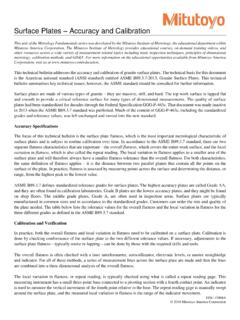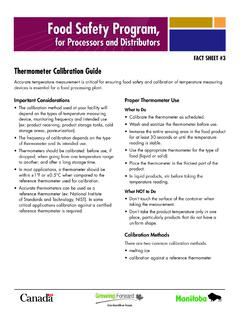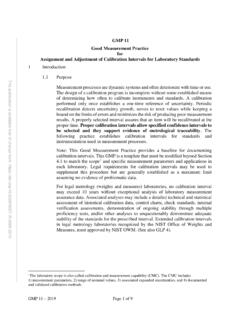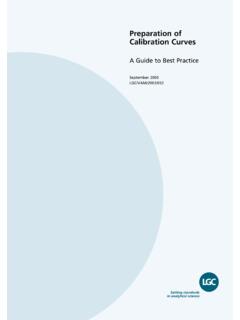Transcription of Accuracy and Calibration of Calipers
1 EDU-15003A 2018 Mitutoyo America Corporation Accuracy and Calibration of Calipers This unit of the Metrology Fundamentals series was developed by the Mitutoyo Institute of Metrology, the educational department within Mitutoyo America Corporation. The Mitutoyo Institute of Metrology provides educational courses, free on-demand training videos, and other resources across a wide variety of measurement related topics including basic inspection techniques, principles of dimensional metrology, Calibration methods, and GD&T. For more information on the educational opportunities available from Mitutoyo America Corporation, visit us at This technical bulletin addresses the Accuracy and Calibration of digital, dial, and vernier Calipers . The technical basis for this document is the American national standard (ANSI standard) entitled ASME This technical bulletin summarizes the most important technical issues; however, the ASME standard should be consulted for further information.
2 Accuracy Specifications Two Accuracy specifications cover the most important metrological characteristics of Calipers . In accordance to the ASME standard, as well as the international standard ISO 13385-1, these two characteristics are called the partial surface contact error, E, and the scale shift error, S. The partial surface contact error applies to any measurements made using the outside measuring faces, and the scale shift error applies to measurements using any other measuring faces available on the caliper, such as inside, step, and depth measurement. The key difference is that all specifications apply when the zero is set using the outside measuring faces and therefore there is the possibility of larger errors when using the other measuring faces. The table below lists the default specification values that are in the ASME standard. These specifications are stated as maximum permissible errors, or MPE values, for the E and S errors.
3 These values are only defaults the manufacturer or user may state different values. Mitutoyo generally states values that are equal to or less than the values shown in this table. Mitutoyo specifications for Calipers are quite similar to these values, and many customers may find the best practice is to simply adopt theses values for their own caliper calibrations. Measured Length, L Digital Resolution / Dial or Vernier Scale Interval in. in. mm mm mm mm in. EMPE in. SMPE in. EMPE in. SMPE in EMPE mm SMPE mm EMPE mm SMPE mm EMPE mm SMPE mm 0 L 50 0 L 2 50 L 100 2 L 4 100 L 150 4 L 6 150 L 200 6 L 8 200 L 300 8 L 12 300 L 400 12 L 16 400 L 500 16 L 20 500 L 600 20 L 24 600 L 700 24 L 28 700 L 800 28 L 32 800 L 1000 32 L 40 For complete definitions of EMPE and SMPE please see the ASME standard.
4 These specifications are a function of the measured length, L, not the overall measuring range of the caliper. The decision rule that applies for these specifications is Simple Acceptance with a test uncertainty ratio, TUR 4. All specifications apply at 20 C. EDU-15003A 2018 Mitutoyo America Corporation Calibration and Verification The most important aspect of the Calibration of a caliper is to verify conformance with stated Accuracy specifications. In accordance with the ASME standard, the conformance verification tests for EMPE and SMPE are described below. Using the outside measuring faces, conformance to EMPE is verified by measuring gage blocks, a caliper checker, or other reference standards across the measuring range of the caliper. A minimum of three to five test points is required depending on the measuring range of the caliper (see ASME for details). At least 90% of the measuring range shall be covered.
5 In addition, the reference standards shall be located at various positions on the measuring faces, from close to beam to near the tip of the jaws. Conformance to SMPE must be verified for all the other modes of operation that are possible with the caliper with at least a single test point. The reference standard for testing the inside measurement is typically a caliper checker, a ring gage, or gage blocks and accessories. The default size for testing is between in (20 mm) and 2 in (50 mm). For depth and step measurements, the reference standard is typically a gage block on a surface plate. A square gage block provides a useful hole to insert the depth bar. By default, the size for testing shall be less than 2 in (50 mm). The internal measuring faces on many styles of Calipers use crossed knife-edges. Due to the thickness of the faces and the clearance between them, additional errors can occur when measuring small internal diameters.
6 For Calipers that utilize cross knife-edge measuring faces, ASME requires an additional test using a in (5 mm) diameter ring gage for all Calipers with measuring ranges up to 12 in (300 mm). The selection of the test points should be considered carefully when calibrating Calipers . ASME defines general rules but also allows the user/customer to select the test points. In cases of used Calipers , there may be times where cyclic errors may occur, on dial Calipers the test points should orient the pointer at various angles within the dial. In addition, for used Calipers , the condition of the measuring faces should be checked carefully for wear (see details in ASME ). The Mitutoyo Calibration Laboratory in Aurora, Illinois, offers accredited calibrations (A2LA ) of Calipers as well as all the measurement standards needed to calibrate Calipers . The Mitutoyo Calibration Laboratory is the premier dimensional Calibration laboratory in the United States.
7 Customers are welcome to visit and tour the Calibration Laboratory. Contact 888-MITUTOYO or email In addition to offering the most complete line of dimensional measuring equipment and solutions, as well as the highest-level commercial Calibration and inspection laboratory in North America, Mitutoyo America Corporation offers educational courses, customized on-site seminars, and online educational resources. Find out more at , email or call 888-MITUTOYO or 630-723-3620. Testing near the tip of the close to the beam

















